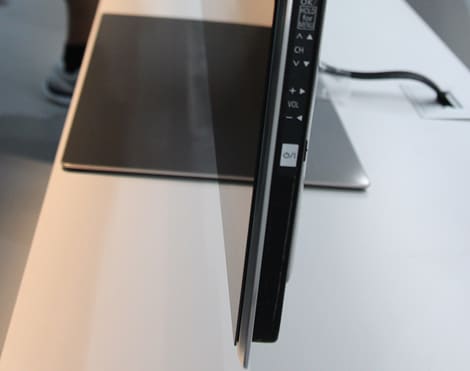Pros
Cons
Introduction
Front
{{section_header}}{{section.name}}{{/section_header}}
The {{product.name}} uses an 85-inch LCD display, but it was hard to see how thick the bezel was and learn much about the front besides the huge screen. As is the case with many proof-of-concept floor models, this TV rested inside black casing so we could barely see its outline.

Back
{{section_header}}{{section.name}}{{/section_header}}
Because this wasn't a product model and we couldn't see the back of the {{product.name}}, we couldn't tell how exactly the 8K video was being fed to the TV. We do know, however, that there was a huge amount of data being processed at rapid speeds so there was likely a slew of cables coming out of the back of it.

Sides
{{section_header}}{{section.name}}{{/section_header}}


Stand/Mount
{{section_header}}{{section.name}}{{/section_header}}

Display Size & Technology
{{section_header}}{{section.name}}{{/section_header}}
Super Hi-Vision, which is the term used in Japan for what we know as "High Definition", uses 4000 scanning lines to increase screen quality while making the experience more realistic for users. The TV's 7,680 x 4,320 resolution is a whopping 16 times the resolution of a 1080p TV. It also has 22.2 multichannel sound system, its luminance is 300 candela per square meter (cd/m2), and its LCD panel has a UV-induced multi-domain vertical alignment. NHK's 8K technology will be on display to viewers in the US, UK and Japan during the 2012 Olympics in London via the BBC. The 8K video on display, produced by NHK, was PBS's "Time of Man" located in Washington, DC.
The {{product.name}}'s screen uses a light-emitting-diode panel to increase image quality and even though we were extremely close to the screen at the show, we weren't able to see pixels and the picture didn't decrease. One of the most impressive aspects of this TV is the way background images, normally out of focus, on such a large display are just as clear as the picture in the middle of the screen.
Some experts view 4K and 8K technology as a gimmick because they argue that users won't notice the difference in picture quality unless they sit close to the screen, and if they're that close they won't be able to see the whole picture anyway. However, larger TVs are undoubtedly on the rise as they become easier to manufacture. Customers want thinner, lighter and bigger TVs and manufacturers are responding to those calls. While 4K or 8K makes little sense for a 55-inch TV, having 80-inch TVs be the norm in living rooms in a few years isn't that far-fetched. If and when that time comes, the extra resolution may be a boon to the viewer rather than an unnecessary add-on.

Brightness, Blacks and Contrast Ratio
Motion & Refresh Rate
Conclusion
{{product.vanity}}
Obviously, you won't be able to bring home an 85-inch {{product.name}} anytime soon, but it was still interesting to see the potential of the technology. We were only able to see an 8K video provided by NHK so there wasn't much variation in the content. However, its resolution is 16 times what we currently consider to be pretty good resolution in 1080p, and it was hard not to envision this type of TV being in customers' home theaters down the road.
Specs
{{manufacturer_specs_table}}
Meet the tester
Patrick Ouellette is a valued contributor to the Reviewed.com family of sites.
Checking our work.
Our team is here to help you buy the best stuff and love what you own. Our writers, editors, and experts obsess over the products we cover to make sure you're confident and satisfied. Have a different opinion about something we recommend? Email us and we'll compare notes.
Shoot us an email